By Joe Berk
It occurred in an instant, on the fifth and last round in the magazine. It was as if a cherry bomb had gone off in my face. I heard a voice yell “whoa!” and I realized the voice was mine.
I stared at the smoking Springfield Armory 9mm 1911 in my hands, waiting for the pain, the blood, and whatever might follow. My hands, still wrapped around the grips, were stinging. I knew something bad happened, but I didn’t know how bad it was and I wasn’t especially looking forward to finding out. My gun had blown up. The entire gun was smoking and smoke continued to waft from places it wasn’t supposed to: The grips, the line between the frame and the slide, the trigger, around the hammer, and the ejection port (which was closed; at this point, I didn’t know if there was a live round in the chamber). Gray smoke curled out everywhere.
I slowly relaxed my grip and looked at my hands. There was no blood, but my palms stung like they had been slapped with a baseball bat. As I eased my hold, the 1911’s left grip fell away in two pieces (as you can see in the photo at the top of this blog). There were no cuts and there was no bleeding, but I had powder tattoos all over both hands. I returned my focus to the gun. It was still smoking. It smelled funny, too. Was that burnt flesh or just the powder and residual oil?
The first four shots from that magazine were delightfully tight, and I ordinarily would have felt good about seeing that. On each of the preceding four shots (and the fifth one, for that matter), the front sight had been outlined against the blurred rear sight and the bright orange muzzle flash, the way things are supposed to look when the hammer drops.
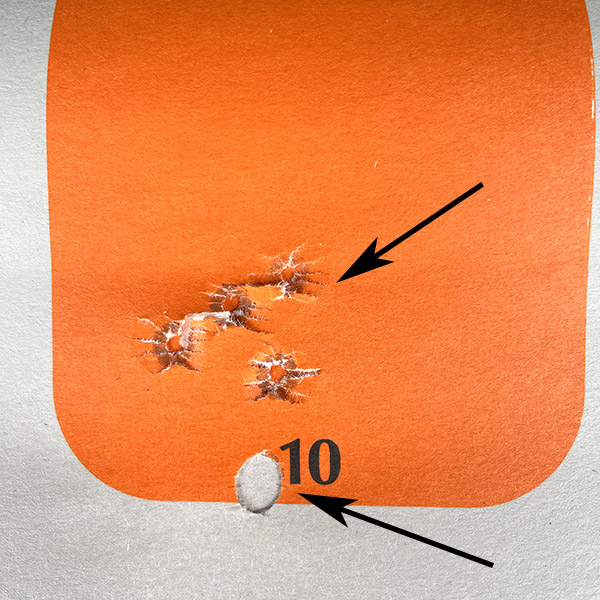
I was still afraid to look at my hands. My face was now tingling and I knew I’d caught something. I had safety glasses on and I could see okay; that was good. I worked up enough courage to put the gun down and look at my hands more closely. They seemed okay. I knew from previous bad things happening that sometimes you don’t feel anything for a few seconds (the golden minute, I think they call it), but I looked again and I was okay.
The 1911’s right grip appeared to be intact (but it wasn’t; more on that in a second). The slide was locked forward. I tried to pull it back but it would only move about an eighth of an inch. I pressed the magazine release and nothing happened. I pulled on the magazine and it came out. It was mangled; the front was bent in and the follower angled upward. I still wasn’t sure if there was a live round in the chamber. I cocked the hammer and dropped it a couple of times…and there was nothing. I concluded it was safe to put the 1911 in its case. I scooped up my marbles and left. I didn’t even pick up my brass, and this was Remington brass that had only been reloaded once…that’s how shook up I was.
When I got home, I looked in the mirror. I had one little spot on my right cheek that bled and had already stopped (I’ve done worse shaving). I washed my hands to get the powder residue off (that took a while). There were no cuts. Dodged a bullet, I did. Figuratively and literally.
Once home, I examined the 1911 more closely. The trigger was too far forward in the frame. The event probably screwed up the trigger mechanism. The right grip, which I thought was okay, had a hairline crack along its length. Not that it matters; you can’t buy just one grip (you buy them in pairs). The slide would not move to the rear more than a little bit; it was not coming off the gun.
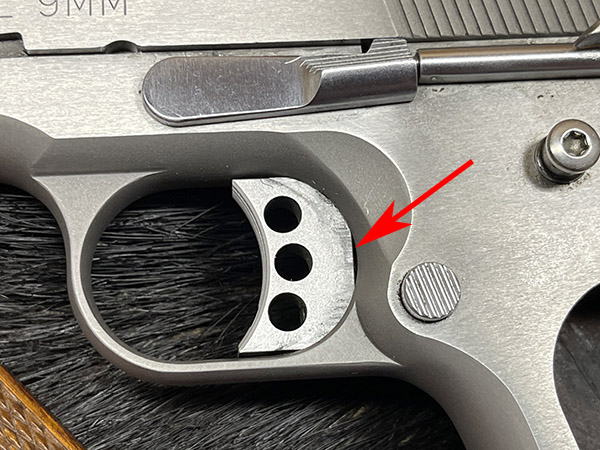
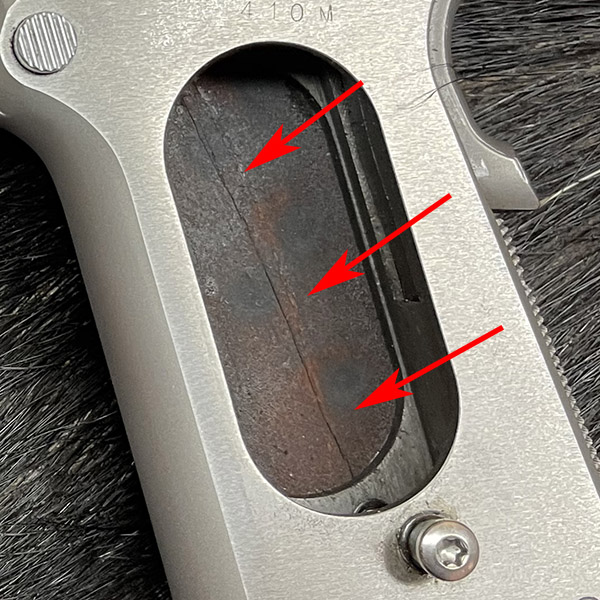
What could have caused this? There are a lot of possibilities. The first (and most likely) is that I double charged a cartridge case when reloading. In other words, I put twice as much propellant in the case as I should have. Of all the reloading equipment I’ve ever used, it’s easiest to do this on the Lee turret press I’ve been raving about. I’m not badmouthing Lee or their turret press; I’m simply making an observation. If that’s what happened, it was entirely my fault.
I could have fired a squib load, had a bullet lodge in the bore, and then fired another bullet on top of it. I’m pretty sure that is not what happened because of the holes on the target. There are four clean holes from the first four rounds, and one lower, oblong hole from the fifth round (when the gun blew up). You can see this on the target above. The bullet didn’t have as much energy behind it and it had started to tumble.
I could have experienced a case failure in which the rear of the case tore off, which would have allowed the hot gases to impinge on the gun internally. There’s some evidence to suggest this. I can look into the bore and see that the cartridge case is still present, but the interior of the case is partly torn away. The lower third of the case’s base is gone (the upper two thirds are present). In the area where the case’s base is gone, I can see the breech face and the firing pin. I later found part of the cartridge case inside the magazine.
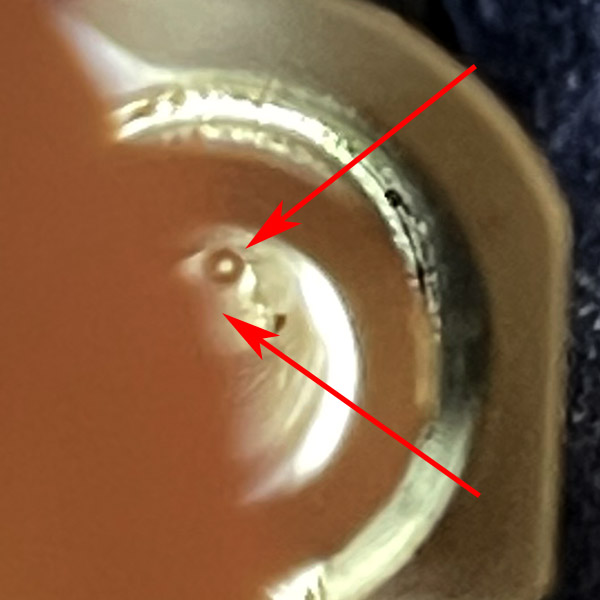
The gun could have fired out of battery. That is to say, it may have fired without the slide being fully forward. I can move the slide back about 1/16-inch, cock the hammer, and the trigger will release it. I don’t know if it is doing that because the internals are damaged, or if it could do it before the event. Or, there could have been grit in the chamber that prevented the cartridge from chambering completely. When I look into the bore, I can see residual blue powder coating from the bullet that seems to be lodged between the case mouth and the forward edge of the chamber.
I cast around on the Internet a bit and I found several references to the 9mm 1911 Springfields having tight chambers. I know mine has a very tight chamber. Maybe a cartridge wasn’t resized completely and it failed to completely chamber? If that happens, the slide won’t go all the way forward and the gun shouldn’t fire so I don’t think that’s likely, but who knows.
After I returned home, I examined the magazine again and I could see what I thought was an imprint of the primer on the magazine. I shook the magazine and felt something rattling around inside. It was the primer. It had been flattened, and there was a hole where the firing pin had struck it. I’m guessing the hole was caused by the excess pressure.
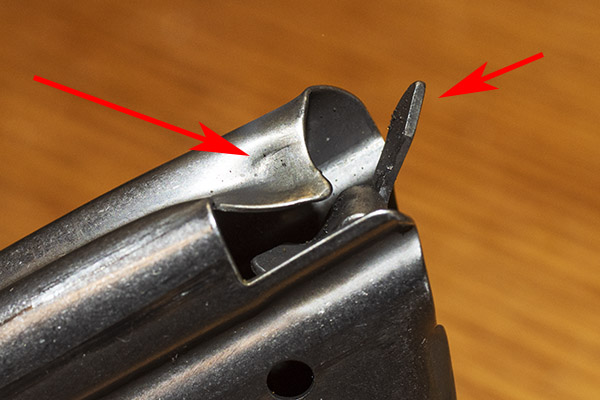
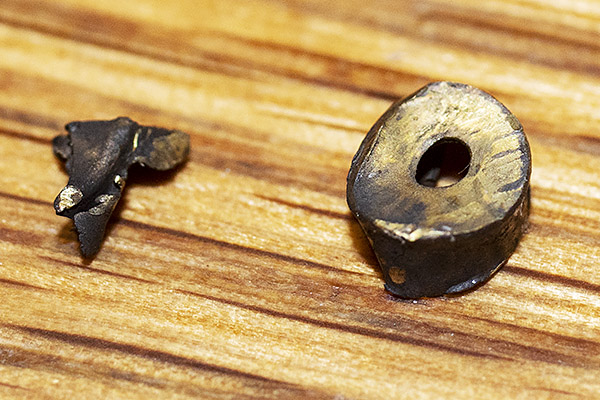
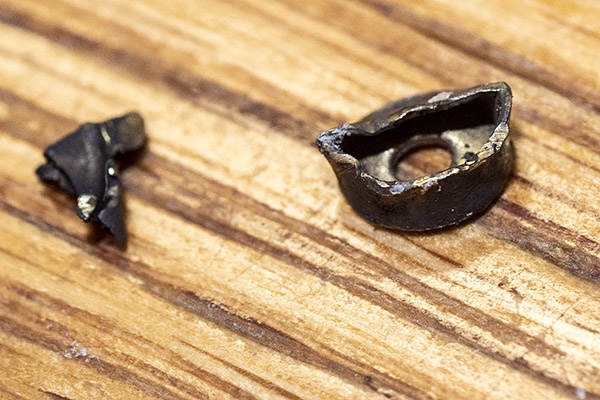
My Springfield 1911 is toast, at least for a while. I have two ways I can go on this (well, three, if you count scrapping the 1911 altogether, but that’s not a choice I want to consider). One option is to return the gun to Springfield Armory, but I don’t want to do that. If the failure was a problem with the gun, I don’t want to have the same guys who screwed it up attempt to fix it. Every gun I’ve ever bought from Springfield has required at least one warranty repair (including this one, but for a different issue). Two of my friends bought 1911s from Springfield and they’ve had to go back for warranty repairs (one had to be returned twice when they didn’t fix the problem the first time). I don’t know what Springfield’s warranty repair turnaround times are these days, but it’s probably measured in weeks or months. The last thing that ruled out a warranty repair was that this event occurred with my reloaded ammo and that voids the warranty. I’m not in denial here; it is likely my reloaded ammo is the reason this happened.
Nope, I’m going to go with the approach that’s always worked for me. It’s the silver lining in this sad tale (that and the fact that I wasn’t injured). I’m bringing the 1911 to TJ’s Custom Gunworks tomorrow. I’ve already talked to TJ and he tells me my 1911 can be repaired. The repairs will be on my dime, but I know the work will be perfect and I know the gun will literally be better than new. I’ll have TJ do a bit of custom work while he has the gun, too. TJ told me he’ll have to cut slide release off to remove the slide from the frame, and when he disassembles it, we’ll learn more. I’m thinking a double charge is the likely culprit (which would be my mistake), but maybe TJ will find otherwise. I’ll keep you posted.
I had a serious debate with myself about posting this blog. It’s an interesting story; that puts it in the plus column. If I double-charged that case, that’s an admission of carelessness on my part and that puts it in the minus column. In the end, if it helps other people from making the same mistake (assuming the fault lies with me), this blog will have served a purpose and that is why it is here.
Please click on the popup ads!
Never miss an ExNotes blog:
More good reloading and firearms stories are here.
Join our Facebook Milsurp Target Shooting group.

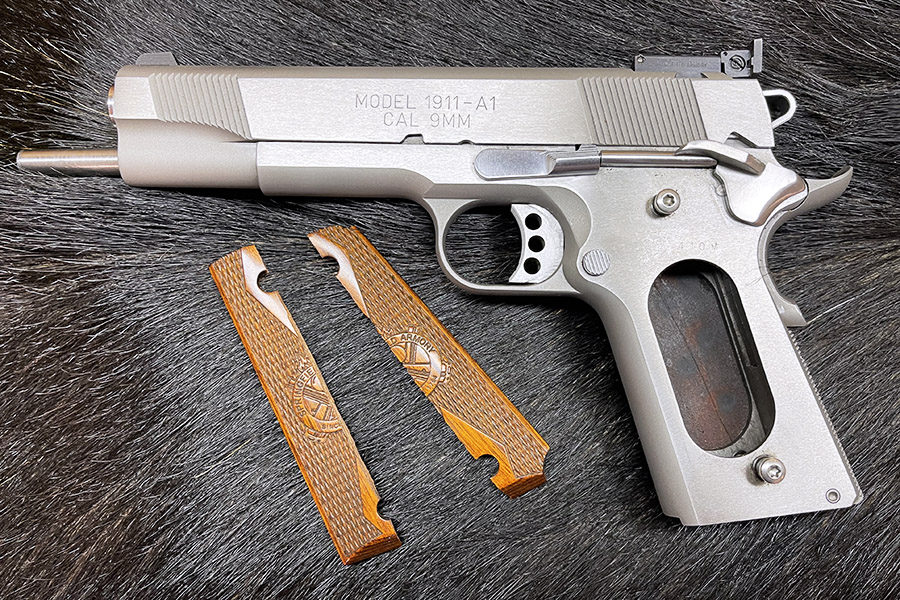
Joe,
Looks like that could’ve been a lot worse. Glad you came out basically unscathed, except for perhaps your pride.
I have very little pride, John.
Glad ur ok
Me, too!
The last time I used a Lee progressive press I had a double charge that ruined an irreplaceable S&W. I don’t use progressive presses anymore.
I’ve had similar thoughts, Don. Not quite there yet.
You are right to post this story as honestly as possible. We learn nothing from the “I had to lay ‘er down” guys. I always wondered but was always afraid to ask if there are some situations where you can’t be sure if there’s a bullet in the barrel or not in a slide action gun. Now I know. Could you look down the barrel with a dental inspection mirror?
The Springfield 1911 has a small slot at the top rear of the chamber where you can see if there is a brass case present (i.e., a loaded round). On my 1911 imnmediately after this event, that was covered in powder residue, so I couldn’t be sure. I inserted a cleaning rod in the bore and noted its depth; that told me there was not a loaded round in the gun.
I tried looking down the bore once I knew that I did not have a loaded cartridge in the chamber, but I couldn’t see anything. Then I used a flashlight. It’s how I grabbed that photo in the blog.
Yikes! I appreciate your humble honesty. Not a lot of that around these days.
I am looking forward to seeing the results of the investigation.
Thanks, Larry.
Joe – Thanks for posting honestly about this incident. How can we learn if we hide from the truth? And if you are at fault it just proves that you are human. As you know I am in the car repair biz and I tell people who have wrecked their cars that if you walked away with only a lesson and nobody really got hurt its a blessing in disguise. And knowing TJ, you will know for certain real soon. And when he is done it’ll go from being a lesson learned to one of the best in your safe. So think of this as a god given gift – an important lesson that could have been real expensive but you got a real bargain on.
Good inputs, Bob. Thanks.
It not often these days to even hint something might be one’s own fault….so this a refreshing read!
We all fear the dreaded double charge. Thats why I never upgraded from my single stage press. I triple check each case. But I am way slower than my friends. When they load a 1000 rounds, I load 200. I cannot afford to scrap and replace a gun here in South Africa. The licensing process is just too difficult.
I hear you, Dude.